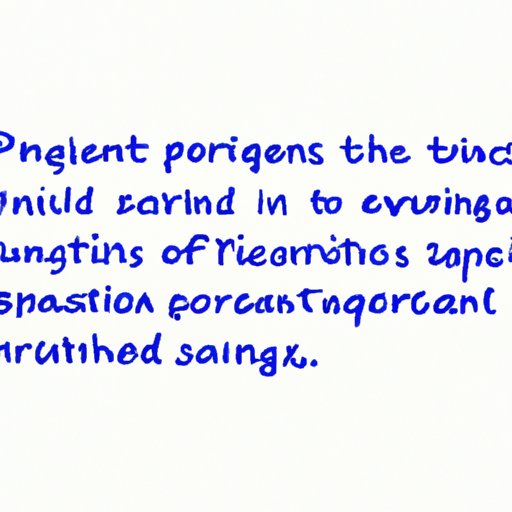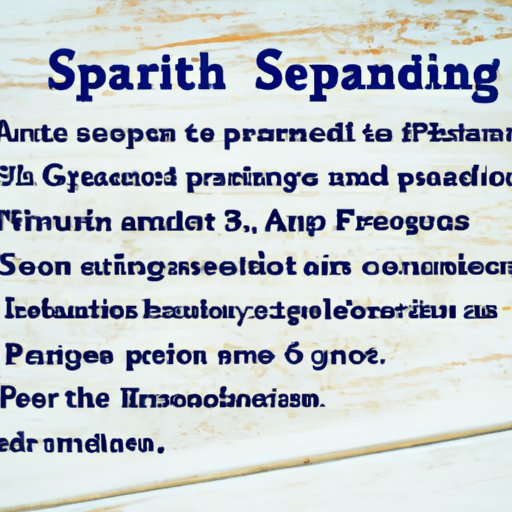
Introduction
As a writer, your ultimate goal is to communicate effectively with your audience. One key way to do this is by mastering the art of concluding paragraphs. A well-written conclusion can be the difference between a forgettable piece and a compelling work that leaves a lasting impression. In this article, we will explore various techniques and tips for effectively concluding paragraphs.

5 Effective Techniques to Conclude a Paragraph and Leave an Impression
Effective conclusions can take many forms, but here are five techniques that have proven to be effective:
Summarizing Key Points
One common way to conclude a paragraph is by summarizing the key points discussed. This technique is vital when writing informative pieces as it helps readers understand the main idea effectively. A good summary should be brief but informative, highlighting the key takeaways from the preceding paragraph.
Using a Provocative Statement
Another effective way to conclude a paragraph is by using a provocative statement. This technique shocks the reader and leaves them with a new perspective to ponder. However, this technique should be used sparingly, as overuse can lead to a loss of impact.
Asking a Rhetorical Question
Rhetorical questions can be incredibly powerful in concluding paragraphs. They encourage readers to think critically about the topic at hand, making it more memorable. A successful rhetorical question should be thought-provoking, relevant, and align with the overall point of the article.
Using a Metaphor or Analogy
A well-placed metaphor or analogy can assist readers in better understanding complex ideas. They help express ideas more vividly and allow readers to connect with the subject emotionally. Be mindful of the audience’s knowledge, making sure to use unambiguous metaphors or analogies that are in line with the article’s message.
Incorporating a Call to Action
Concluding a paragraph with a call to action urges the reader to take action of some kind. This technique is commonly used in informative or persuasive pieces to encourage the audience to do something like sign a petition or donate to a cause. A well-crafted call to action should be clear, easy to accomplish, and aligned with the broader message of the article.
The Art of Wrapping Up: Tips for Concluding a Paragraph with a Bang
Here are a few tips for crafting effective conclusions:
Emphasizing the Relevance of the Topic
It’s essential to stress the relevance of the topic at hand in the concluding paragraph. Readers should feel that the topic matters, and it’s relevancy explained in a manner that connects to their interests or current reality. This is a crucial step in guiding the reader’s appreciation of the article and internalizing what you want them to understand ultimately.
Creating a Sense of Closure
As the writer, creating a sense of closure is critical. A paragraph should feel complete, with no loose ends left untied. This is important in creating a coherent sense of connection between each paragraph, linking the ideas and thoughts in a continuous stream. The reader should have a sense of finality when they have finished reading the paragraph.
Using a Powerful Quote
A well-selected quote from an authoritative figure can increase the credibility of the writer’s words. Quotes are powerful because they show that the ideas and arguments within the piece have been extensively researched and are more widely accepted, thereby encouraging the reader to understand your points more effectively.
Creating a Lasting Impression
A conclusion should be as memorable as it is effective. If a reader remembers the points raised in your writing but forgets the conclusion, they’re unlikely to act on them. As such, it’s key to craft a conclusion that sticks in the reader’s mind long after they have read your article and encourages them to act on your message.
Saying Goodbye: Best Practices for Concluding a Paragraph
Avoiding Redundancy
A conclusion should be brief and to the point. Redundancy can cause readers to lose interest and ultimately defeated the paragraph’s purpose. Be mindful of how much information you provide in the conclusion, making sure not to repeat ideas or rephrase statements discussed in the main body of the article.
Avoiding Overused Phrases
Overused phrases like ‘in conclusion’ or ‘finally’ can make a conclusion seem amateurish and unoriginal. Instead, try and use phrases that add value to the concluding paragraph, emphasizing your unique perspective and opinion on the topic.
Writing Concisely
Concluding a paragraph concisely is an art. Rambling at the end of the article may cause readers to lose interest and give up before they grasp your message. Writing a powerful call to action in a few well-crafted sentences is more effective than several paragraphs that convey the same message.
Mastering the Art of Concluding Paragraphs: A Comprehensive Guide
Understanding the Role of Conclusions
The role that conlcusions play in your writing is helping to position your work in light of the current body of literature. A conclusion is supposed to demonstrate the relevance of your work, provide closure on the topic, and show how your work fits into the larger discussion. Understanding this definition is key to composing effective concluding paragraphs.
Exploring Different Conclusion Types
There are several types of conclusions, including a summary, final perspective, conclusive call to action, and return to the introduction. Understanding the distinct elements of each conclusion type is critical in selecting the most effective way to conclude a particular article.
Providing Examples of Effective Conclusions
The most effective way to understand how to write an effective conclusion is to examine well-constructed examples. Examining these examples will assist you in creating effective conclusions that resonate with your audience.
When to End a Paragraph and How to Do it Right
Identifying Natural Break Points
The critical element of ending a paragraph is identifying nature break points. This process is affected by how the ideas flow — a change to a new topic with a different perspective naturally signals a time for a new paragraph. The writer needs to recognize where this should occur to maintain coherent writing flow.
Avoiding Abrupt Transitions
Transitions from one paragraph to the next need to be smooth and coherent. Abrupt changes can confuse readers, resulting in lost interest and frustration. Ensure that each paragraph transitions seamlessly into the next, allowing the ideas conveyed to flow naturally.
The Power of a Strong Conclusion: Tips for Ending Paragraphs Effectively
Importance of a Strong Conclusion
A compelling conclusion has the power to inspire readers to reflect on your work, convince them of your key points, or motivate them to take action. Effective concluding paragraphs leave a lasting impact on readers, resonating and encouraging them to share the message with others.
Providing Examples of Effective Conclusions
Examples of strong conclusions provide insights on how to write effective concluding paragraphs. Exploring the different approaches will help you find a style that works best for your writing.
Conclusion
Recap of Reasons to Conclude Paragraphs Effectively
The importance of effectively concluding paragraphs cannot be overstated in the success of your writing. A powerful conclusion connects with readers, highlights the relevance of the topic, and encourages them to take action or remember the message conveyed in your work.
Final Thoughts
Mastering the art of concluding paragraphs requires practice and experimentation. Through this process, you will become more confident and skilled in identifying the right technique for conveying your message effectively. Adopting the tips and techniques identified in this article is a foundational step toward crafting effective concluding paragraphs.
Call to Action
If you’re working on any piece that requires writing, consider hiring an expert to craft your concluding paragraphs for maximum impact.





